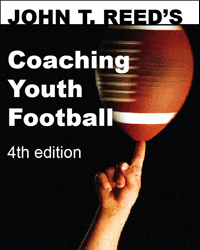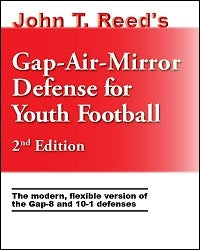What drills should a youth football coach use?
Posted by John Reed on
Copyright John T. Reed
I am often asked what drills I recommend for youth coaches. The more drills you do, the fewer games you win. Most football drills waste precious practice time and thereby make the team less successful.

First, let me define some terms.
Definitions
Drill. A drill is a repetitive, narrowly-defined, and closely-supervised activity. The purpose of drills is to inculcate into players habits which they resist. Example: Football players must participate in nightly tackling drills because the way they would tackle otherwise, grabbing opponents shirts, is totally unsatisfactory, whereas the way the tackle after much proper drilling is satisfactory.
Drills perfect a given, very specific technique and are only appropriate for crucial techniques that almost all kids refuse to execute correctly unless drilled to do so. Fortunately, there are only a few such techniques. Unfortunately, the vast majority of coaches behave as if all football techniques fit that category and waste most of team practice time running unnecessary drills. (Click the banner below to see how to condition your players without using the last 15 minutes of every practice with conditioning drills.)
Repetition. A repetition or rep is one iteration of a football skill. When you merely rep a skill rather than drill it, the players are free to experiment on their own initiative with different approaches to find the best one for them. Example: Centers and long snappers need many repetitions, but they should be relatively unsupervised or guided by coaches when doing so. Repetitions enable players to perfect skills so subtle that the coach is unable to perceive the differences that make up the difference between success and failure.
Chalk. Chalk or chalk talk is a verbal classroom-style explanation of a football skill or play. Most skills are learned faster if the physical doing of the skill or play in question is preceded by a chalk talk explanation of it. However, virtually no skill or play can be learned by chalk alone. Example: Offensive plays are typically introduced first by chalk talk. Chalk shows the big picture and provides both a verbal and a visual learning opportunity. Virtually all chalk must be followed by at least one physical repetition of the activity in question to add muscle memory and a sort of mental hologram of doing the thing in question to the learning.
Put-ins. Put-ins are all the first-time activities which result in a team being able to correctly and consistently execute a certain play on offense or offensive special teams or stop certain plays on defense or defensive special teams. To put a youth-football offensive play or defensive stop in, you generally have to chalk it, walk-through it, run it at full speed to get the timing right, and correct any individual technique errors on an ad hoc basis. The walk-through phase takes the longest.
Walk-through. In a walk-through, players walk through a skill or play or discharging a defensive responsibility. The opposing scout team, if any, is generally passive and motionless and plays the role of statues to let the practicing unit demonstrate knowledge of their assignments. Example: The fit-and-freeze in which each offensive player walks to the appropriate defender and positions the correct block against the correct defender then freezes in that position until checked by the coaching staff.
Scrimmage. Full-speed practice game with coaches on the field to closely observe and control the activity. Example: Defenses need full-speed scrimmages in order to see the offensive plays of the upcoming opponent at game speed and thereby learn to react correctly and quickly. Rookies need full-speed scrimmages to acclimate them to the nature of football especially hitting. Offenses sometimes benefit from full-speed scrimmage for the purpose of getting timing down on plays involving post-snap exchanges of the ball or coordination of late-developing blocks or pass routes. Quarterbacks need to experience a pass rush and pass coverage in order to become acclimated to it. It is very difficult for coaches to see the details of what is going on in a scrimmage, so only very limited coaching can occur. During scrimmages, the players largely coach themselves and each other. Most coaches spend far too much time scrimmaging. At the college and NFL levels, it is a rarely used.
Looking the part
When coaches ask me for drills, I fear they are totally lost and they figure if they do some established football drill, no one will recognize that they do not know what they are doing. Many youth coaches also figure that drills are what coaches do and that successful team performance on game days somehow follows from vigorous drill execution, thats why drills have been around so long. They must work, these coaches assume.
Just 20 minutes of drills per two-hour practice
In a two-hour practice, I would typically do about twenty minutes total of drills. That would be my form tackling and one-against-two defensive-line drills and my wide-pursuit, pass-pursuit, gang-tackling, and Oski drills, all for the defense. Pursuit drills are one a day. Oski (interception) and pass pursuit are done together on one day. I do no drills at all for offense or special teams, although I do give centers, long snappers, quarterbacks, kickers, and receivers a ton of reps as defined above. Some coaches might think those were drills. They are not because they are do-it-yourself after initial coaching, not closely supervised by coaches like drills.
Gotta do put-ins
Put-ins take forever on offense and offensive special teams, not as long on defense. You are required almost by rule to put in at least one of each of the following eight plays or defensive schemes:
- an offensive play
- a defense with its individual responsibilities against each possible play
- a punt and coverage responsibilities
- a kickoff and coverage responsibilities
- a punt return or black
- a kickoff return
- a PAT kick
- a PAT kick defense
Is there literally a rule that says you have to put these things in? Almost. The rules say one team will kick off to begin the game and the other will receive. In general, those positions are reversed to start the second half. And so on.
At least eleven eleven schemes to put in
As a practical matter, one offensive play is not enough. You need at least four offensive plays. That means so far you have to put in eleven different offensive and special teams plays plus defenses. Both first and second string must know how to do the play or stop. Furthermore, your offense must know how to block each offensive play against each of your upcoming opponent's defenses and your defense must know how to line up against each of your opponent's offensive formations, how to react to various shifts and motions, and how to read each of their plays.
Put-ins take many, many hours of practice time
It takes hours and hours for your twenty-two offensive players (first and second strings) to master their assignments for just one play against each of your opponents defensestypically the 5-3-3 and 6-5 and sometimes the 6-2 (wide-tackle six or split six) or 4-4. If you are chomping at the bit to run offensive drills, my response is that you may run drills just as soon as your have put in your offensive play book. You have successfully put it in when no matter what play you call or what defense your scout team is lined up in or which string is on the field, every single player goes to the correct defender and takes the correct position to block that defender, the ball carriers all take the correct paths, and any ball exchanges are made smoothly at full speed.
If you have, say, eight offensive plays, and you start August first in shorts, put-ins of your offense, defense and special teams may take you all of every practice until about November first. Then you can do some drills, although your team would probably be better off adding a new play than drilling techniques they are generally executing adequately.
Process orientation versus results orientation
I suspect the problem is a process orientation. Process-oriented people feel what they are doing is OK as long as they are doing what they are supposed to do, regardless of whether it gets results. Bureaucrats are like that. They make you fill out their forms and care not a whit about results, only procedure.
Football coaches who are preoccupied with drills are the same. Somewhere along the line they got it in their heads that a football practice consists of drills and scrimmage, so if they are doing drills and scrimmaging, all’s right with the team. Of course, there's still that little problem of being 1-7, but they can always blame that on the players.
Results
What is needed is a results orientation. Results-oriented coaches run a play and tape it. Then they look at the tape. If the play failed, they scrutinize the tape to figure out why. Then they fix the problem. 95% of the time on offense, the problem will be a player not knowing whom he was supposed to block. If you focus on results rather than process, you will soon discover that virtually all of your offensive problems and about half of your defensive problems stem from players not knowing assignments. If you then focus on getting players to learn their assignments, as you should, you will end up spending most of your practices running fit-and-freeze or some similar activity. And your team will start winning.
Detailed versions of the correct approach are in my various football coaching books.
Share this post
0 comment



